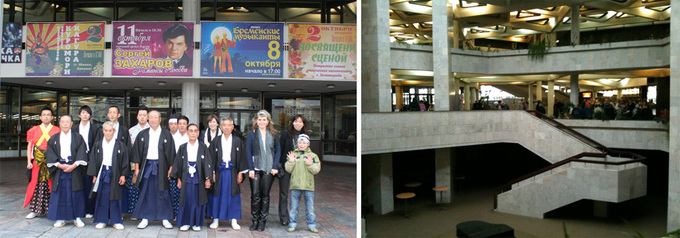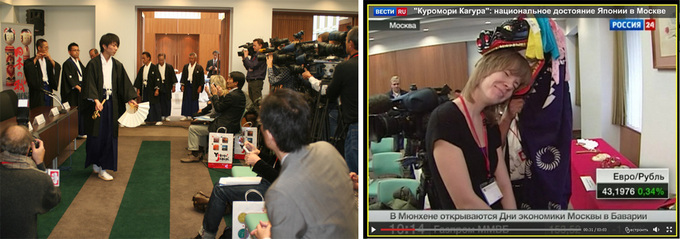The Kuromori Kagura Premieres in Moscow, Sending a Message of Recovery
Yoko Kitagawa
Performing Arts Section
Arts and Culture Dept.
The Japan Foundation
The autumn leaves were beautiful when the members of the Kuromori Kagura Hozonkai (Kuromori Kagura Preservation Association) from Iwate Prefecture visited Moscow in early October. http://www.jpf.go.jp/e/culture/new/1110/10-01.html
The Kuromori Kagura, or sacred music and dance of Kuromori, is a distinctive traditional performing art that has been carried on since the Edo period (1603-1867). The group is based at Kuromori Shrine in the city of Miyako and tours a wide area of the prefecture from the city of Kuji in northern Iwate to Kamaishi City in the south. They perform while moving in a procession from town to town. We asked the kagura troupe to visit Moscow because we were impressed by the spectacular intensity of their performance, and because this cultural heritage is rooted in the Tohoku area on Japan's northeast coast where the earthquake and tsunami struck in March 2011. Kuromori Kagura was designated by the Japanese government as an important intangible folk-cultural property in 2006. It has not been performed overseas since an appearance at the Smithsonian Museum in the United States twenty-five years ago, and this will be the group's first show in Moscow.
The kagura troupe traveled 12 hours by bus to reach Narita New Tokyo International Airport, before boarding the 10-hour non-stop flight to Moscow the following day.
The first of two performances scheduled in Russia was held in the city of Zelenograd, one to two hours by car from Moscow's city center. It was chilly and drizzling when we started out for the venue. Located in the northern suburbs of Moscow, Zelenograd was originally developed as a center for the precision technology industry during the Soviet era, and was populated by leading engineers from around the country. Today, about 200,000 people live in the area. Compared to downtown Moscow, there are not many opportunities to see Japanese culture in this city; nevertheless, many local people are interested in Japan's language and traditions. On the day of the show, a large poster of the Kuromori Kagura was hanging at the main entrance of the theater, a building with old-fashioned charm, and many people were lined up in the lobby waiting for the doors to open.
The appeal of Kuromori Kagura lies in the lively music and dramatic dancing, and the Moscow performance showcased these features. The audience was truly engrossed in the spectacle unfolding in front of them, which they were probably seeing for the first time. The last number was Ebisu mai (the dance of Ebisu), which comically depicts Ebisu, the god of happiness and wealth, catching fish. A Russian boy in the audience suddenly jumped up and joined in the dance. He got so carried away that he pulled the string off from the fishing pole, which elicited a gale of laughter from the audience. We also talked to two cute little girls who told us that they were learning Japanese at school. They took pictures of themselves standing next to the wooden lion's head used in the dance. The lion's head is called Gongen-sama, and is worshiped as a manifestation of the deity at Kuromori Shrine.
The second performance and a press conference were held on the following day. The questions flew at the press conference, as the assembled journalists asked about the experiences of those who had lost homes or ships in the tsunami. They were also interested to learn that the troupe members are not professional performers, but work to carry on this tradition while holding down other jobs. The wooden lion's head and masks attracted a great deal of attention. The journalists were fascinated to hear that it is considered good luck to let the wooden lion bite you; the tradition is that the part of the body that is bitten will be safe from illness. Newspapers, and the national television, among other stations, carried pictures of Gongen-sama biting their reporters.
The show was held in the evening, and twenty couples were invited from the Russian Ministry of Emergency Situations, which had sent an emergency relief team to Japan just three days after the quake in March. The second performance featured a program slightly different from that of the previous day. When the fifth and last number ended, the audience burst into applause, not stopping until the group responded to the cheers with a splendid encore performance.
Although the two-day visit to Moscow was rushed, we could feel the emotion of the spectators, who were moved by the kagura group's commitment to carrying on their tradition, and by their unwavering determination to rebuild their battered hometowns. But the person most deeply touched by seeing the group's dedication to kagura may have been myself. The kagura tradition is deeply rooted in the community, and depends on the local people who offer lodging to the traveling performers. Without the community, the tradition would not go on. I would like to thank the Kuromori Kagura Hozonkai who are all very busy with the reconstruction process underway in their hometowns, for taking time from their busy schedules to participate in performances in faraway Moscow. I pray constantly for the speedy recovery of the devastated areas.
Related Events
Back Issues
- 2025.9.30 The 51st Japan Found…
- 2025.9.30 The Japan Foundation…
- 2025.9.30 Bringing the World C…
- 2025.9.30 The 51st (2024) Japa…
- 2025.9.30 Japan Foundation Pri…
- 2024.5.24 The 50th Japan Found…
- 2024.3. 4 Movie Theaters aroun…
- 2023.4.10 The 49th Japan Found…
- 2023.3.28 JF's Initiatives for…
- 2023.1.27 Living Together with…





